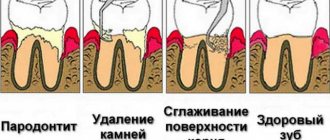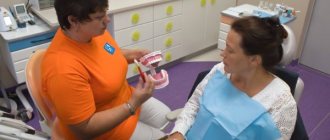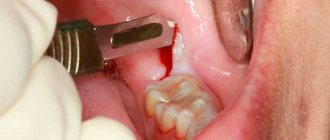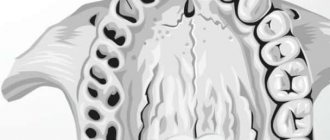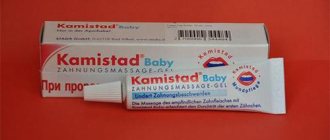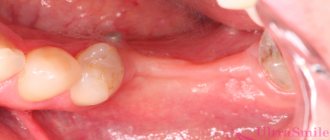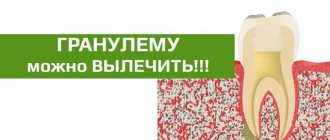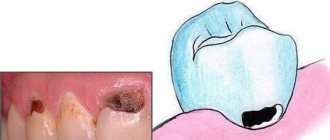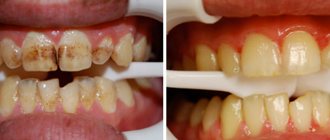You simply need this procedure if your tooth has decayed, broken, fallen out, or been removed by a dentist. In all of the above cases, the tooth socket remains unprotected, so foreign objects, tooth fragments, food particles, microbes and infection can penetrate there. This will ultimately lead to inflammation of the socket, diseases of other teeth and gums, as well as destruction of bone tissue.
To avoid troubles and protect your oral cavity from diseases, you should immediately contact your dentist for curettage of the tooth socket. The procedure is absolutely painless, as anesthesia is mandatory. After the onset of anesthesia, the dentist cleans the alveoli from the blood clot. Next, using a curettage instrument, it removes excess particles, foci of inflammation, and damaged tissue. And at the final stage, treat the hole with an antiseptic, and also apply a cotton swab with medicine. For complete curettage of the tooth socket, one procedure is sufficient.
Tooth care after curettage
In addition, dentists recommend not using a standard brush to clean your teeth after curettage, since the tooth socket is very vulnerable, and due to the stiffness of the bristles of a regular brush, you can injure it, causing bleeding and inflammation. Dentists advise using a surgical brush.
The 12,000 bristles of the surgical brush are made of polybutanediene terephthalate, which does not absorb water and toothpaste. Thanks to this property of polyester, the brush always remains soft and cannot in any way damage the inflamed area, in this case the tooth socket that has undergone curettage. But with all its super soft structure, the brush does an excellent job of removing plaque and other contaminants. In addition, the surgical brush is absolutely antibacterial, for the same reason that it is waterproof, so it will serve you for a long time, even after the tooth socket has healed, especially since its price absolutely justifies the quality.
You can purchase a surgical brush in the “Special Care” section of the Noex Dent online store catalog. Delivery to any point in Moscow and Russia is 2-3 days. You can also find here many useful tools and materials for caring for your oral cavity. We always advise our clients not to be lazy and take care of their teeth, because, as you know, a beautiful smile “will make everyone brighter.”
Curettage is a dental procedure associated with disinfection of the cavity left after tooth extraction: elimination of abscess foci, disinfection and cleansing of fragments and particles of a destroyed filling, as well as other foreign bodies that can cause inflammation. Cleaning the alveolar socket after tooth extraction helps the healing process of the postoperative wound.
Typically, cleaning the postoperative socket is carried out immediately after tooth extraction. But if necessary, medical intervention is possible even a few days after the procedure. Most often, it is required if an inflammatory process has begun in the hole, which is associated with infection of the wound.
Another possible reason for curettage is that there is no effect of the so-called dry socket. For the wound to heal as quickly as possible, it is necessary to form a blood clot in the hole. It is this mass of coagulated blood that ideally protects an open wound from the penetration of bacteria. Sometimes a clot does not form due to specific diseases of the patient associated with blood clotting, or is simply washed away with saliva. To prevent inflammation, the dentist has to perform a curettage procedure.
If the inflammation is not stopped in time, it can develop into a serious disease and result in osteomyelitis of the bone.
Those patients who, for some reason, did not undergo curettage of the postoperative cavity should inspect the socket daily and monitor for the slightest signs of inflammation. If there are any painful manifestations (constant or periodic) when biting or palpating the extracted tooth, you should immediately contact a dentist to clean the canal and treat the source of inflammation. During the curettage process, the doctor frees the hole from decaying infected tissue, which helps it heal more quickly.
Curettage of the socket of an extracted tooth, what is it. Tooth socket curettage – what is it?
Many dental diseases have to be treated surgically. After the tooth extraction operation, the hole is subjected to curettage. The procedure is not always carried out; there are indications for this, namely:
- dry socket syndrome;
- the presence of purulent contents;
- necrosis of the alveolar walls;
- crumbled hard tooth tissues;
- alveolitis formation.
Curettage of the extracted tooth socket in the absence of a blood clot is necessary to prevent wound infection.
After curettage, the wound is closed with a gauze pad. Early removal or rinsing with antiseptic solutions leads to washing out the blood clot. As a result, the damaged areas become infected and an inflammatory process develops. Uncovered areas of nerve endings cause sharp, spontaneous pain and pain from food irritants. Dry socket syndrome occurs more often after wisdom teeth are removed, and occurs within a few days. The danger of such a manifestation lies in the formation of alveolitis, the clinical picture of which is shown in the photo.
Painful symptoms should gradually decrease and be virtually absent by the third day. If this does not happen, and the discomfort only increases, then you should immediately consult a doctor.
In the presence of suppuration and an increase in body temperature, alveolitis is diagnosed. Curettage of the tooth socket will help remove pathological formations and prevent the development of further complications such as phlegmon and abscess.
The stages of curettage of the tooth socket will be as follows:
- pain relief in the form of conduction and infiltration anesthesia;
- washing away food debris, pus and blood clots;
- thorough curettage of the bottom and walls of the hole;
- repeated washing with an antiseptic solution and drying the wound surface;
- application of anesthetic powder;
- closing the wound with a special bandage that will prevent re-inflammation and speed up regeneration.
After curettage of the gums, rapid healing is observed. Gradually, the wound is covered with restorative pink tissue without the presence of foreign inclusions.
Curettage procedure for periodontal diseases
In case of periodontal diseases, a curettage procedure can also be performed, but not the sockets, namely the periodontal pockets. This action is resorted to in cases where complex therapy does not bring the desired results and it is necessary to use patchwork or plastic surgery, as well as operations on the soft tissue of inflamed gums.
Unfortunately, quite often patients turn to the dentist in advanced stages of the disease, when the only treatment option is surgical intervention. It is necessary to remember that you should regularly undergo preventive examinations at the dentist and immediately consult a doctor if the slightest signs of inflammation occur. If you have swollen, painful and bleeding gums, simple therapy will not help. Therefore, the periodontist opens the inflammatory foci and cleans the teeth of subgingival deposits that cause peritonitis.
Curettage methods
Such an operation, depending on the current situation, is carried out in several ways:
- Closed curettage In the initial stages of periodontitis, as well as in the early stages of periodontal disease, closed curettage is allowed. And then, only in cases where the pocket deepening does not exceed five millimeters. Closed cleaning is carried out by a doctor almost blindly. After all, a slight inflammation of the gums makes it impossible to look under it. Therefore, the procedure is carried out with utmost care so as not to cause harm to nearby growing healthy teeth and tissues. One type of closed operation is vacuum cleaning of pockets. The procedure is carried out using curettes attached to a device that creates a vacuum. Of course, with such curettage, all exfoliated particles are instantly removed and do not settle on the walls of the pocket. This manipulation definitely reduces the risk of complications in the postoperative period.
- Open curettage Open curettage is a direct surgical intervention used in the inflammatory process when the size of the gingival cavity exceeds five millimeters. Using a scalpel, the surgeon opens the lesion and separates part of the gum from the tooth. Next, using a special tool, a curettage spoon, the exposed roots are freed from stone deposits and dead tissue. Then the roots, free of any deposits, are polished with a special nozzle.
The next stage is treating the pocket with various antiseptics used in dentistry. Then, preparations are placed into the disinfected cavity to improve the structure and mineralization of the bone tissue of the tooth. After all these manipulations with the periodontal tissue, the flap of the mucous membrane is repatriated back. The interdental papillae are sutured and finally a universal bandage is applied to protect the operated gum from penetration of pathogenic microbes and foreign objects.
Sometimes a bandage soaked in antiseptics and anti-inflammatory drugs is not applied. This method is used for severe bleeding from damaged gums in order to avoid hematoma formation and subsequent complications. The healing process and changing of the bandage is controlled by a doctor. If healing occurs without problems, the sutures are removed ten days after they are applied.
Gum curettage, as well as socket curettage, is used in the complex treatment of periodontal disease. Such surgical intervention is resorted to in the most advanced cases of the disease.
However, like any gum treatment, gum curettage has several contraindications
:
- bleeding gums;
- a large accumulation of pus under the gum tissue;
- tooth mobility;
- stable deposits of plaque and stones under the mucous membranes;
- infectious diseases of the mouth that can aggravate the course of the disease.
Curettage of the hole after tooth extraction, cleaning of pockets and gums is a very effective way to treat dental diseases. Such surgical intervention allows you to quickly get rid of foreign bodies in the socket in case of tooth extraction, and in case of periodontal disease, from the deepest dental deposits and formed purulent cells. Timely curettage is a guarantee of a quick recovery. Therefore, you should not neglect the operation suggested by the dentist. Any curettage is performed under local anesthesia. Therefore, the surgical intervention will be completely painless.
It is worth noting the rules of behavior in the postoperative period. Do not touch the operated area of the gum with a toothbrush or dental floss. It is not advisable to consume hot food during the wound healing period. It is allowed to apply cold to relieve inflammation and swelling. In the first hours after curettage, it is recommended to drink drinks only through a straw.
The possibilities of modern dentistry are great and the doctor can help the patient even with the most advanced cases. However, do not forget that a preventive examination and timely visit to the dentist will help to avoid complications and surgical interventions. After all, everyone knows the truth that a disease is easier to prevent than to cure.
Have you missed a couple of routine dental checkups and missed your gum disease? It can happen to anyone, because at first periodontitis is asymptomatic. When the gums become swollen, begin to hurt and bleed, bad breath appears and the teeth turn yellow from plaque - everyone runs to the doctor.
At such stages of gum inflammation, curettage of periodontal pockets is indicated - mechanical removal of subgingival deposits. It is carried out in open and closed ways. Read more about each in our article.
Carrying out the procedure
Like any surgical intervention, curettage is performed under anesthesia. The doctor gives an injection to numb the inflamed area.
If sensitivity is high, a cooling gel can be applied first.
The hole is cleared of foreign bodies (pieces of food), saliva or clots of decomposition using a syringe with an anesthetic solution.
Next, the doctor removes particles of dental tissue decay, tooth grains or stuck food using a special instrument - a curette. Cleaning is carried out with extreme caution so as not to cause further damage to the hole.
After scraping, the hole is washed out again with an antiseptic solution.
Next, a small turunda with a medicinal preparation is introduced into the cavity of the hole, or the wound is sprinkled with a special agent (xeroform or iodoform). Modern dentists try to do without tampons, because after a few hours they can cause re-inflammation, triggering the growth of bacteria.
After this procedure, the inflammation goes away within two to three days, and the hole begins to heal quickly. However, in addition to curettage, the doctor, in addition to standard recommendations, may prescribe physiotherapeutic procedures. Despite the fact that the hole heals quite quickly, pain can last up to two weeks, gradually fading away.
Description of the procedure
Curettage of a periodontal pocket is carried out using a special instrument - a dental curette (another name is a curettage spoon).
A curette is inserted into the gum pocket and all plaque accumulated in the pocket is scraped out. The procedure is painful, so it is performed under local anesthesia.
In case of advanced periodontitis, granulation tissues are also removed. They replace atrophied bone tissue, which has dissolved under the influence of toxins secreted by bacteria “living” in the pocket.
It is worth noting that scraping subgingival deposits does not replace full-fledged professional teeth cleaning. This is just one stage of it, along with removing tartar and soft plaque from the enamel, as well as polishing the surface of the teeth.
Open operation
The purpose of the operation is the same as in the case of closed curettage. But, unlike it, the periodontal pocket itself is also removed here , as a probable source of bacteria and a factor of possible relapse.
Indications
- The depth of the pocket cavity is more than 5 mm.
- Severe proliferation of granulation tissue.
- Changes in the shape of interdental papillae.
- Detachment of the gum edge from the surface of the teeth.
Contraindications
- Possible necrotic processes in the gum tissue.
- It's too thin.
- Abscess.
- The appearance of pus in the surrounding tissues and the cavity itself.
- Various infectious dental diseases.
Methodology
As in the closed method, there are certain stages of the operation.
- Treatment of the entire oral cavity with antiseptics, pain relief.
- Making an incision along the tops of the interdental gingival papillae.
- Peeling of the internal and external parts of the gums, as well as the mucous flap to a sufficient depth (no more than the depth of the formed cavity).
- Complete removal of all deposits and diseased tissues with visual supervision by a physician. The tools used at this stage are scalers, hoes, curettes.
- Polishing of all surfaces of the tooth and its roots.
- Excision of altered and diseased periodontal tissues.
- Removal of granulate and epithelium that has grown into the pocket.
- Antiseptic treatment. Laying the papillae and then fixing them with a surgical suture. Applying a protective bandage with anti-inflammatory drugs.
After the operation, the same procedures are recommended as for the previous technique.
How to perform open curettage of periodontal pockets - see the following video:
Methods of conducting
- Cleaning pockets without damaging the integrity of the gums.
Vacuum curettage
Closed curettage, which uses a vacuum device to instantly remove the scraped plaque from the pocket.
Before scraping out the plaque, the gum is cut and peeled away from the tooth.
Laser curettage
Instead of a curette, a laser device is used, under the influence of which the plaque evaporates.
Cryo-curettage
A special cryo-probe destroys plaque with ultra-low temperatures.
Chemical curettage
Before removing plaque, it is softened with lactic or citric acid.
Most dental clinics use closed and open methods - they are considered traditional when removing subgingival deposits.
The technique is justified if the depth of periodontal pockets does not exceed 5 mm - at the mildest stages of periodontitis. Its peculiarity is that the doctor performs the procedure virtually blindly, since there is no opportunity to look under the gums. At the same time, delicacy is very important; if you work carelessly, you can damage healthy gum tissue and scratch the surface of the tooth.
This surgical procedure is performed in cases where the depth of the gum pockets is more than 5 mm. Using a scalpel, the surgeon makes incisions in the gum and peels off a flap of its mucous membrane from the teeth.
The exposed roots are thoroughly cleaned of plaque and granulation tissue and then polished. The area is treated with antiseptic agents, after which an osteogenic preparation is placed into the periodontal pockets to stimulate the restoration of bone tissue.
Then the gum flap is returned to its place, sutures are applied in the area of the interdental papillae, then a protective gum bandage is applied. The sutures are removed ten days after the operation.
After the procedure you cannot:
- stop caring for the oral cavity (germs can enter tissues weakened after surgery and cause inflammation);
- touch the area of the gum where the procedure was performed with the brush;
- eat solid food for the first two to three days;
- spit.
- avoid hot food and drinks until healing;
- use antiseptics - wipe your teeth with solutions of Chlorhexidine, Miramistin, rinse your mouth with these and similar drugs after meals;
- if necessary, apply cold, which will help relieve inflammation after surgical procedures;
- drink only through a straw in the first hours after open curettage, so as not to cause bleeding.
When to curettage gum pockets
The most important indication is inflammation of the gums, in which periodontal pockets more than 3 mm deep are formed. This means that the gums “lag behind” the tooth, and as a result, a cavity is formed between them, into which microbes penetrate.
This can happen against the background of the following diseases:
- periodontitis;
- periodontal disease;
- gum injuries.
1) Formation of periodontal pockets
As soon as the periodontal attachment is destroyed, so-called “periodontal pockets” are formed between the gum and tooth. At first they are relatively small. Shallow periodontal pockets up to 4.0 mm deep correspond to mild periodontitis, and closed curettage may be indicated for precisely such patients (to prevent the progression of periodontitis).
Periodontal pockets are localized between the gum and the root of the tooth (Fig. 2). One wall of the pocket is the surface of the tooth root, on the surface of which microbial plaque and subgingival tartar are attached. The other wall is the inner surface of the unattached gum, which is covered with pathological epipelium and granulations. Thus, the typical contents of a periodontal pocket are dental deposits, granulations, and pathological epithelium.
This is interesting: Hood on a wisdom tooth: removal methods, the need for excision (incision) in case of inflammation
Scheme of the structure of the periodontal pocket -
As we said above, in the absence of treatment, the depth of the pockets gradually increases. This occurs due to the destruction of the bone plate around the tooth, as well as periodontal fibers, due to which the tooth root is firmly attached to the bone. This gradual process inevitably leads to the appearance of tooth mobility, the increase in the degree of which in the future will be directly related, among other things, to the continuing increase in the depth of periodontal pockets.
2) Destruction of bone tissue around the tooth
As was seen above, the periodontal pocket “grows” deeper due to the destruction of periodontal fibers between the root surface and the bone plate, which also leads to the destruction of the bone graft itself (alveoli). Moreover, it should be noted that bone tissue does not simply disappear without a trace, but is replaced by the so-called inflammatory granulation tissue, which contains a large number of microbial cells, osteoclasts, etc. On an x-ray, the absence of bone around the teeth looks like this (Fig. 3b).
Clinical situation No. 1
Next, in Figures 4-6, you can see exactly what a deep periodontal pocket looks like under the gum in the interdental space between the canine and premolar in the lower jaw. As we can see from the outside, the gums look quite healthy, and only on an x-ray (Fig. 5) can we see a slight darkening between the roots of the teeth, indicating the presence of destruction of bone tissue. But we have a completely different look after the gums are detached and granulations are cleaned out of the pocket between the teeth (Fig. 6).
In Fig. 6 we see a deep bone defect of a large volume, as well as subgingival calculus on the surface of the tooth root (indicated by an arrow). Such deep periodontal pockets can no longer be sanitized using the closed curettage technique, which is carried out without gum detachment and therefore does not imply visual inspection of bone defects in the depths of the periodontal pocket (i.e., the doctor will simply blindly try to clean out what to clean out from under the gums).
Therefore, for pockets larger than 4.0 mm, only open curettage or flap surgery should be used. For medium and deep periodontal pockets, only these methods allow you to remove all granulations and dental deposits from under the gums, carefully scrape out the pathological epithelium from the inner surface of the gums, and also replant synthetic bone tissue in the area of deep bone defects (with the hope of partially restoring bone levels ).
Why is it impossible to do without curettage in the treatment of periodontitis (in principle)
With shallow periodontal pockets up to 4.0 mm, provided that you have good equipment (a good scaler, a Vector device) and the painstaking work of a periodontist, it is still possible to stop the progression of chronic periodontitis. The biggest challenge will be removing subgingival deposits from periodontal pockets, which is difficult to do even in shallow pockets, given that the work is carried out almost blindly.
When deep periodontal pockets have formed (more than 4 mm deep) and granulation tissue has formed at their depth, the process essentially becomes irreversible, despite any conservative local and general anti-inflammatory therapy. You can drink antibiotics, rinse your mouth with antiseptics, smear your gums with anti-inflammatory gels, irradiate your gums with a laser, but all this will be ineffective. Why?
- Firstly , it is impossible in principle to completely remove dental plaque from deep periodontal pockets. The fact is that the doctor inserts the ultrasonic attachment under the gum “blindly”, i.e. he makes movements without seeing what exactly is happening in the periodontal pockets. Therefore, some dental plaque necessarily remains in the pockets.
- Secondly , if deep periodontal pockets have formed, then in them, even after removal of dental plaque and anti-inflammatory therapy, conditions are created for the development of infection and further progression of periodontitis. The fact is that the pockets are filled with granulations, without surgical removal of which it is impossible to stop further destruction of the bone tissue around the tooth.
It turns out that you can still try to remove subgingival dental deposits and granulations in shallow pockets using ultrasonic cleaning and closed curettage techniques. It will be possible to do the same thing efficiently in deep pockets only by performing open curettage or patch surgery.
Pros and cons
Benefits of the procedure:
- the possibility of eliminating pathological gum pockets. Open curettage is the only method that allows you to achieve this result);
- restoration of bone tissue due to the implantation of osteopreparations using an open technique;
- getting rid of pathological tooth mobility. When bone tissue is restored, teeth are held stronger;
- low cost of closed curettage.
There are also many disadvantages. First of all, the low effectiveness of closed curettage for moderate and severe periodontitis (in 99.98% of cases the disease recurs) and the high cost of the open method (in addition to the doctor’s work, the total cost includes suture material and osteogenic preparations).
- duration of the open curettage procedure.
Approximately 2 hours to work in the area of 6-7 teeth;
high requirements for the qualifications of a doctor.
Otherwise, there may be injuries to the mucous membranes and damage to the teeth.
Open curettage of periodontal pockets should be performed exclusively by surgeons specializing in periodontology. On our website you can find clinics that successfully treat periodontitis using a similar technique.
An effective method of eliminating gum disease in dentistry involves gum curettage. Between the edge of the gum and the cervical area there is a depression in which food debris constantly accumulates.
For pathogenic microorganisms, these conditions are a favorable environment, and they begin to multiply vigorously, provoking inflammatory processes in the oral mucosa at the site of tooth attachment. This may cause it to be lost.
What is curettage in dentistry? This is a deep cleaning of periodontal gum pockets, performed in various ways. If you know what this procedure is, then you will have to “tremble” much less before visiting the dentist.
Why is curettage needed?
How does a periodontal pocket form?
The oral cavity requires constant self-care. Food remains accumulate in space. They, reacting with microflora, cause deposits of various types, which are localized on the surface of the tooth in the area where it emerges from the gums, where saliva almost does not wash the enamel. Tartar is formed, which is firmly attached to the enamel and can penetrate into the subgingival space.
This phenomenon provokes the onset of an inflammatory process, causing changes in bone tissue. The process of atrophy of dentin and root cement and their replacement with granulation tissue begins. In place of the destroyed bone tissue, a cavity forms, the teeth are no longer attached to the gums properly, and a gum pocket appears in which granules and deposits accumulate.
If this pocket becomes deeper than 3 mm, it is impossible to clean it using home tools - a toothbrush, floss, a special brush and a toothpick. There is a need to perform a curettage procedure.
Indications for the procedure
In the presence of gum pockets, the process of atrophy and destruction becomes irreversible. It is impossible to stop it with local therapy - superficial cleaning and antibacterial agents stop the inflammation only for a short time.
Inside open cavities, pathogenic bacteria accumulate and granules grow, which continue their destructive effect. The gum tissue with the pocket is constantly inflamed; any violation of hygienic requirements or decreased immune status exacerbates the destructive process.
Indications for the procedure:
- acute inflammation of the gums, causing chronic stomatitis and the appearance of trophic ulcers in the oral cavity;
- mild to moderate periodontitis;
- global deposits of tartar and non-flaking plaque;
- formation of pockets more than 3 mm deep, filled with foreign inclusions.
With the help of curettage, all problems are solved simultaneously:
- the area around the tooth is cleaned;
- granulate is removed;
- eliminates increased bleeding of gums;
- The periodontal pocket is removed.
The operation is performed using two methods – closed and open. The cleaning method is chosen by the attending physician depending on the depth of the lesions and the severity of the process.
The operation is not performed if the patient has deep bone pockets, the dentition is abnormally positioned, there is congenital underdevelopment of the jaw, or the gum wall is thinned. The procedure has to be postponed in case of an acute inflammatory process - if pus has already accumulated in the affected area. First, treatment is carried out, and only then curettage is done.
Periodontal pocket curettage technology
The operation can be called local teeth cleaning - during it, plaque is removed from the surface of the tooth, granule formations are removed, then the enamel is polished.
Closed curettage. It is performed when the gum tissue is slightly damaged and the depth of the pockets does not exceed 5 mm. There is no dissection of the gums.
After diagnosis, local anesthesia is administered, special instruments are immersed in the pockets, and accumulated deposits are removed. The doctor has to work blindly and is required to be very precise. After the surgery is completed, the roots of the teeth are polished.
Open curettage.
The pockets are cleaned when the gum tissue is cut.
- First, a thorough diagnosis is carried out based on a visual and instrumental examination; it is necessary to take an x-ray of the affected area.
- Local anesthesia is administered.
- The gum is cut, and the pocket cavity begins to be cleaned.
- Special medications are applied to the tooth tissue to stimulate the growth of bone tissue in place of the damaged and, during surgery, removed.
- Next, the gum is sutured, and sutures are placed at the excision site.
After the incision, the inflamed area between the two incisions is peeled away, exposing the bone tissue. To avoid excessive sensitivity after surgery, a soft tissue transplantation procedure is performed. This also helps to cope with cosmetic defects that appeared during the operation.
In case of significant destruction of dentin and the impossibility of restoring it with the introduction of stimulants, transplantation of hard tissues - gums or teeth - is performed. This effect firmly secures the tooth and stimulates the body to regenerate.
It is not always possible to restore the dentition in one go. In this case, it is recommended to repeat the curettage after 2 months.
As after every operation, the rehabilitation process has its own characteristics:
- While the protective bandage is on the gums, you should not brush your teeth or rinse your mouth.
- The first days you can only eat semi-liquid food.
After the bandage is removed, it is recommended to treat the surgical site with anesthetics and wound healing agents at home.
Curettage in the socket of an extracted tooth
Tooth extraction is not considered a difficult or dangerous procedure, but complications can occur after it.
These include:
- prolonged bleeding;
- long-term pain;
- inflammatory process.
If the painful condition does not go away within 3-5 days, you need to make a second visit to the doctor. Pathogenic microorganisms, foreign objects, and food particles could have entered an unprotected wound. Due to an oversight by the doctor, bone fragments could remain, especially if the tooth was already destroyed and its pulp began to rot.
To prevent inflammation nearby, the socket of the extracted tooth is scraped.
This procedure - unlike other methods of curettage - is not considered a surgical intervention, since the open cavity is cleaned. First, local anesthesia is given - in this case, they try to apply an application - and then the alveolus is freed from the newly formed blood clot.
Accumulated foreign inclusions, damaged tissues, and fragments, if present, are removed instrumentally. Then the hole is treated with an anesthetic - no stitches are required - and tamponed. The hole is cleaned in one procedure.
Despite the simplicity of this dental intervention, after it a rehabilitation period is required for some time, as after any curettage. At home, you need to rinse your mouth with antiseptics, apply anti-inflammatory ointments with antibiotics, and eat semi-liquid or pureed food.
After the curettage procedure - no matter how it is carried out - you should brush your teeth with extreme caution. A soft-bristled toothbrush must be purchased in advance.
The oral cavity requires careful care. After each meal, you need to remove food debris, not allowing them to accumulate, clean the interdental spaces, and visit the dentist annually to remove tartar on time.
This is the only way to prevent the occurrence of periodontitis, which means that you will practically not have to become familiar with the curettage procedure.
And a dental examination showed excessive depth of the periodontal pocket, which means that it is time to carry out curettage.
The curettage procedure is the cleaning of the periodontal pocket using a mechanical or ultrasonic method.
If curettage is not done in time, there is a high probability of tooth loss or the occurrence of other dental diseases.
Curettage of teeth or periodontal pockets is a dental procedure used to treat gums.
The main gum diseases that curettage treats are periodontitis and.
A periodontal pocket is a slotted depression that is located between the edge of the gums and the cervical part of the teeth. It is this gap that accumulates the largest number of microbes and food debris. Therefore, it is very important to clean the area and prevent further buildup.
In normal condition, the periodontal pocket has a depth of no more than 3 mm, which helps to clean it without any effort during oral hygiene procedures.
Otherwise, when the depth of the canal exceeds the normal value, it becomes problematic to brush your teeth with an ordinary toothbrush and there is a high risk of gum disease, tartar and plaque.
Subsequently, all the tissues that take part in holding the tooth in the socket suffer destruction, which leads to the loss of a healthy tooth.
It is this condition of the periodontal canal that is the main symptom that makes a visit to the dentist inevitable.
The main indications for the curettage procedure are:
- inflammation of the gums;
- plaque deposition;
- tartar;
- the depth of the periodontal pocket is more than 3 mm.
People are often confused by professional teeth cleaning. These procedures are not equivalent, although they often overlap.
The main difference between curettage and cleaning is that the first gets rid of deposits of pathological tissues of the periodontal pocket and decay products, and cleaning removes deposits from the surface of the teeth and polishes the enamel.
Timely diagnosis and preventive visits to the dentist will prevent the occurrence of problems with teeth and their further loss. If the pocket depth is more than 3 mm, then the person is advised to visit the dentist more often, as the likelihood of the accumulation of harmful microbes increases significantly.
What is curettage of periodontal pockets?
The recess between the edge of the gum and the cervical part of the tooth is the gingival (periodontal pocket).
Normally, the depth of such a pocket is usually about three millimeters. And in the case when the size of the pocket is larger, this is already a symptom of dental diseases. A medical procedure used in the treatment of periodontal disease is curettage of periodontal pockets. During this procedure, the contents of the periodontal canals are removed : granulation tissue, subgingival tartar, bacteria, their waste products, areas of softened tooth cement.
Causes, consequences and symptoms of pathology
The presence of tartar can be the cause of pathology.
Most often, a periodontal pocket appears because tartar begins to grow in the root area (which was not promptly removed from the coronal part), which is populated by microbes. All this stimulates the inflammatory process, which can only be stopped in the clinic.
The main cause of the pathology is poor oral hygiene or advanced gingivitis, which causes a disease called periodontitis. The risk of periodontitis increases due to hormonal changes (during pregnancy or diabetes, for example), crowded teeth or a lack of hard foods in the diet. Also the cause is periodontal disease, which occurs due to disruption of metabolic processes in the periodontium.
It is important to know! If you don't pay enough attention to the problem, it won't go away. On the contrary, all negative manifestations will only intensify. After all, the source of the disease is located deep in the periodontium, where high humidity and temperature create favorable conditions for the development of pathology. As a result, the gums will become thinner, the bone around the root will become inflamed and dissolve, and the periodontal ligaments will be destroyed.
A person is quite capable of independently determining that problems have begun with the periodontium, because... Pocket formation is accompanied by negative symptoms:
- pain when eating: not only directly when chewing, but due to temperature (hot/cold) or chemical influences (sour/sweet/salty),
- pain when brushing teeth,
- redness, bluishness of the gums: with periodontitis,
- whitish color of the mucous membranes: with periodontal disease,
- tooth mobility,
- a large amount of dental plaque,
- reduction of gingival level and exposure of roots,
- bad breath,
- the appearance of bleeding.
Symptoms of the problem are pain, redness, plaque
Curettage methods
There can be several methods of curettage. The choice of method depends on the depth of the periodontal pockets.
Closed curettage method
This method is appropriate to use when the depth of the pathological pocket varies within five millimeters. In this case, you can do without surgery. This method does not cause severe pain and is carried out in several successive stages.
First of all, it is necessary to diagnose the gums.
Secondly, it is necessary to relieve the patient of the pain threshold by injecting him with anesthesia. Then the pathological pockets themselves are completely cleaned. The procedure is carried out without violating the integrity of the gums using special dental instruments. The final stage is polishing the tooth roots.
The closed curettage method can effectively reduce the depth of the periodontal pocket.
Method of open curettage of periodontal pockets
It is logical to assume that the second method of procedure is used when the depth of the pathological pocket exceeds five millimeters. It is also performed if the closed curettage procedure is ineffective. This method also consists of several steps. It includes mandatory surgical intervention.
- Firstly, as in the previous case, it is necessary to diagnose the condition of the gums.
- Secondly, eliminate the pain factor, that is, give an anesthesia injection.
- Thirdly, the gum needs to be cut so that you can get to the base of the pathological periodontal pocket. In this case, an incision is made in the area of the interdental papillae.
- Fourthly, the pocket is cleaned using dental equipment. In order to stimulate the growth of bone tissue, osteogenic preparations are applied to the damaged part.
- Fifthly, the operation is completed by suturing the incised gum.
Flap surgery
This is a method that involves two vertical incisions in the gum. This procedure is necessary so that the area between the incisions folds back on its own, thereby exposing the tissue of the tooth root. This operation can visually increase the length of the tooth, because its root is exposed. At this time, the roots may react too strongly to external stimuli. When they are exposed to temperature or chemicals, sensitivity increases greatly.
Such an unpleasant effect from the operation can be avoided. In order to avoid this type of consequences, it is necessary to transplant palate tissue in place of the lost gum tissue. This procedure is also useful in that it makes it impossible for recurrent deepening of periodontal pockets and helps to restore the aesthetic appearance and remove increased sensitivity of the teeth.
In very difficult situations there is a risk of bone tissue damage. To improve the situation, it is necessary to transplant bone tissue taken directly from the patient himself or replace it with foreign tissue, animal or synthetic material.
Transplantation is good because it promotes the body’s independent regeneration of tissue. Another plus is that it helps to securely secure the tooth in the socket.
After surgery, you must visit the dentist regularly. The first examination of the condition of the oral cavity is carried out after two months. At the first examination, the doctor determines the success of the procedure or prescribes re-treatment.
Curettage
In order to understand what curettage is, you need to roughly understand where exactly the problem is. Teeth are bony outgrowths that are fed by blood vessels and nerve endings. The root canal goes deep into the gum, which covers most of the tooth, leaving only the coronal part necessary to perform its functionality. However, the gum itself does not fuse with the tooth, creating a hollow area between the tooth and the soft tissue. The greatest separation between the tooth and the gum is located near the crown part, so food debris often gets into this gap, but it is not possible to remove them from there yourself.
Curettage is a dental procedure in which, using special means, a cavity is cleaned, which is also called a periodontal pocket. This procedure relieves inflammation of the gums and eliminates other problems of the soft tissues of the oral cavity. Ultrasonic cleaning agents or surgical instruments can be used to carry out the procedure. The choice of curettage products depends on how deep the separation needs to be cleaned. Also, a similar procedure can be carried out for diagnostic purposes in order to understand the condition of the root canal hidden by the gum.
Curettage instruments
There are two approaches to the curettage procedure:
- using mechanical tools;
- using ultrasound.
Modern dentistry gives preference to ultrasonic curettage, as it allows this procedure to be performed more efficiently, quickly and painlessly.
Additionally, tooth root polishing is carried out, which helps prevent tartar and make the surface smoother.
The dentist may prescribe a course of special medications that can reduce the risk of bacteria in the mouth and stabilize the situation in the mouth.
